Sarah Sundin's Blog, page 16
May 13, 2025
Today in World War II History—May 13, 1940 & 1945
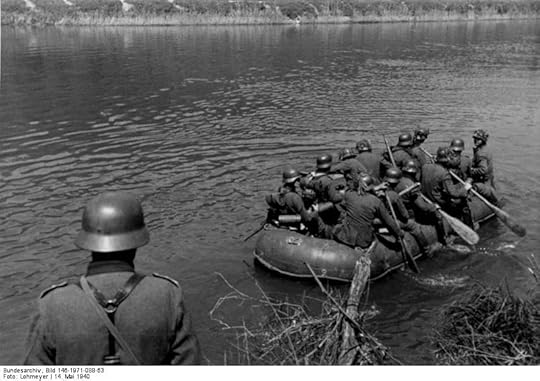
German troops crossing the Meuse River in a rubber raft, near Aiglemont, France, 14 May 1940 (German Federal Archive, Bild 146-1971-088-63)
85 Years Ago—May 13, 1940: In main attack in France, German Army Group B crosses the Meuse at Sedan to trap Allies in the Low Countries.
British Prime Minister Winston Churchill states, “I have nothing to offer but blood, toil, tears, and sweat” in his first parliamentary speech as prime minister.
Queen Wilhelmina of the Netherlands and her government flee to Britain.
80 Years Ago—May 13, 1945: US Fast Carrier Task Force (TF 58) begins raids on Kyushu, Japan, destroying the last of its airfields.
Soviets crush last pockets of German resistance in Czechoslovakia.
The post Today in World War II History—May 13, 1940 & 1945 first appeared on Sarah Sundin.May 12, 2025
Today in World War II History—May 12, 1940 & 1945
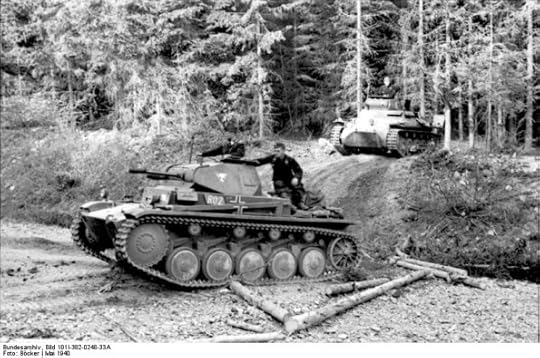
German tank in the Ardennes, Belgium, May 1940 (German Federal Archives: Bild 1011-382-0248-33A)
85 Years Ago—May 12, 1940: First tank battle on the western front—at Hannut, Belgium, French tanks destroy large number of German tanks.
German troops enter France via the Ardennes Forest, reaching the Meuse River at Sedan, Monthermé, and Dinant.
Britain begins internment of 2,000 male German and Austrian nationals ages 16-60 in military areas (eastern & southern coasts).
80 Years Ago—May 12, 1945: Gen. George Patton launches Operation Cowboy, rescuing 1,200 horses, including 375 Lipizzans, from Soviet slaughter in Czechoslovakia.
New song in the US Top Ten: “Sentimental Journey.”
The post Today in World War II History—May 12, 1940 & 1945 first appeared on Sarah Sundin.May 11, 2025
Today in World War II History—May 11, 1940 & 1945
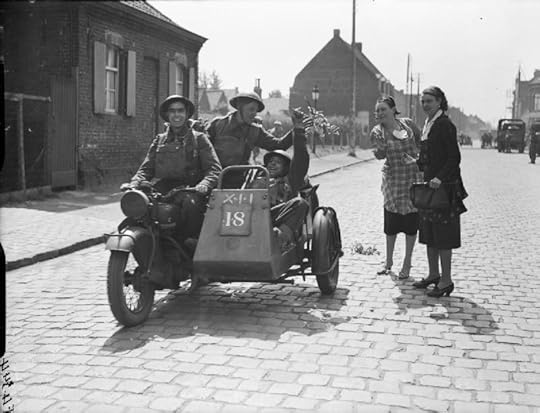
Belgian girls give flowers to British troops riding a Norton motorcycle combination in Herseaux, as the BEF crosses the border into Belgium, 10 May 1940 (Imperial War Museum: F 4344)

Poster for 1940 World’s Fair, New York City
85 Years Ago—May 11, 1940: Germans complete occupation of Luxembourg.
British & French armies join Belgians on River Dyle in Belgium.
Switzerland mobilizes its army, while Swiss citizens living on the German border flee.
British & French land in Dutch West Indies (Aruba & Curaçao) to protect oil installations; US President Roosevelt states these actions do not violate the Monroe Doctrine.
The 1940 New York World’s Fair opens with theme “The World of Tomorrow.”
80 Years Ago—May 11, 1945: Australians launch offensive on Wewak, the last Japanese stronghold on New Guinea, taking Wewak, its airfield, and the last Japanese port in New Guinea.
US Tenth Army and Marines launch offensive on Shuri Line of Okinawa.
The post Today in World War II History—May 11, 1940 & 1945 first appeared on Sarah Sundin.May 10, 2025
Today in World War II History—May 10, 1940 & 1945
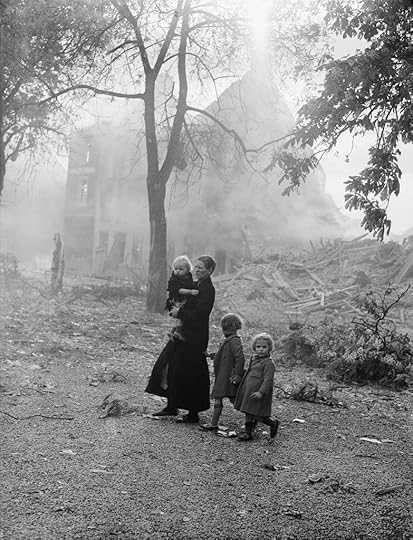
A family of refugees in devastated Enghien, Belgium, after the German invasion, May 1940 (Imperial War Museum: F 4499)
85 Years Ago—May 10, 1940: Germany invades the Netherlands, Belgium, and Luxembourg.
German troops land at Belgian Fort Eben Emael in the first use of glider-borne troops in history.
British Prime Minister Neville Chamberlain resigns and is replaced by Winston Churchill.
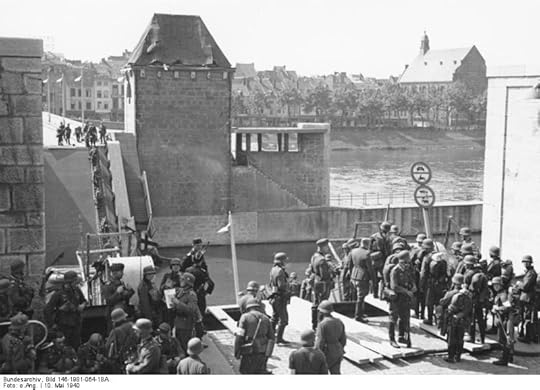
German troops waiting to cross the River Maas in Maastricht, the Netherlands, 10 May 1940 (German Federal Archive: Bild 146-1981-064-18A)
80 Years Ago—May 10, 1945: Last meeting of British MI5’s Twenty Committee, which “ran” their double agents (Read more: “Double Cross—Britain’s Double Agents in World War II”).
US War Production Board lifts ban on producing 73 consumer items.
Britain lifts the blackout along the coast.
The post Today in World War II History—May 10, 1940 & 1945 first appeared on Sarah Sundin.May 9, 2025
Today in World War II History—May 9, 1940 & 1945
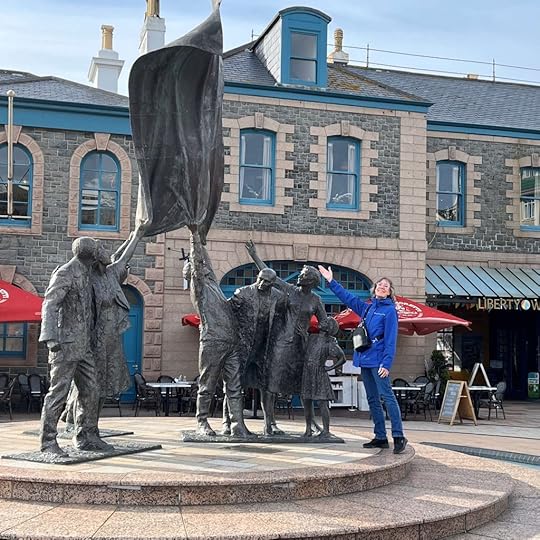
Sarah Sundin at the “Monument to Freedom” in Liberation Square, St. Helier, Jersey, commemorating Jersey’s Liberation Day (Photo: Sarah Sundin, 2 May 2024)
85 Years Ago—May 9, 1940: In Nazi-occupied Poland, Jews are banned from parks, museums, restaurants, trains, and from land ownership.
French scientist Maurice Ponte flies one of his improved cavity magnetrons to Britain, which will lead to British E1189, essential for radar.
80 Years Ago—May 9, 1945: V-E (Victory in Europe) Day is celebrated by the USSR.
British troops liberate the Channel Islands, landing without opposition in Jersey and Guernsey.
Germans capitulate to Czech Partisans in Prague.
The post Today in World War II History—May 9, 1940 & 1945 first appeared on Sarah Sundin.May 8, 2025
Victory in Europe! V-E Day 80th Anniversary!
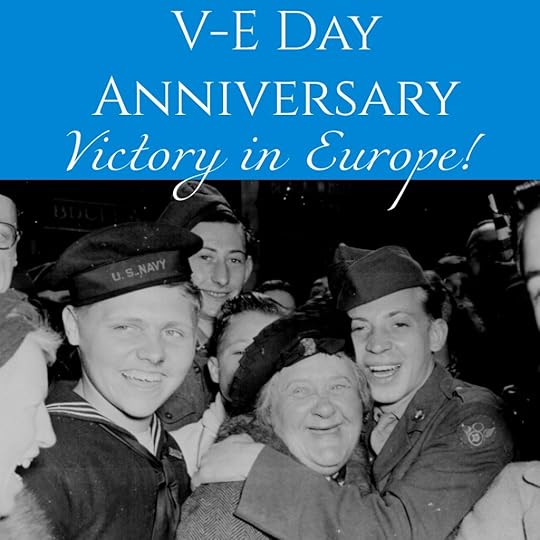 Victory in Europe
Victory in EuropeSince Nazi Germany’s invasion of Poland on September 1, 1939, the free world had been longing for this day. On May 8, 1945, it came. Victory in Europe Day.
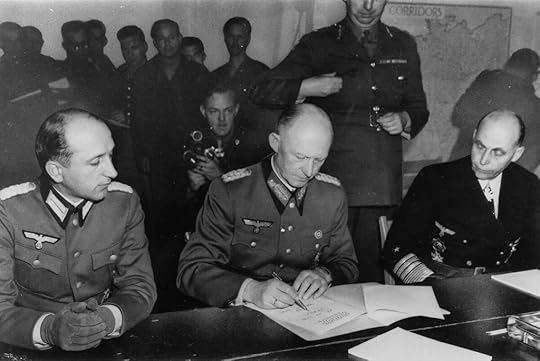
ColGen Alfred Jodl signing the documents of Germany’s surrender, Reims, France, 7 May 1945 (US National Archives: 195337)
For years, the Allied forces had been pushing back Hitler’s armies. On April 29, German forces in Italy and Austria officially surrendered, effective May 2. On April 30, Hitler committed suicide. On May 4, German forces in northwest Germany, Denmark, and the Netherlands surrendered, effective May 5. And finally on May 7, Germany officially surrendered, in Reims, France, effective May 8. The western Allies proclaimed May 8 to be V-E Day. The Soviets demanded a second surrender ceremony in Berlin on May 8 and celebrated V-E Day on May 9.
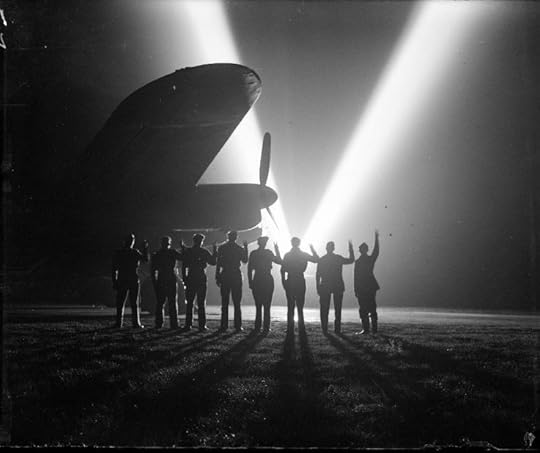
Ground crew on a RAF Bomber Command station in Britain return the ‘V for Victory’ sign to a neighboring searchlight crew. Silhouetted is the nose of a Lancaster bomber (Imperial War Museum: CH 15165)
For the Allies, V-E Day was a day of celebration. Spontaneous parties and conga lines and parades broke out in cities throughout Britain and France and Canada and the USA. People went to church and prayed. American Gen. Dwight Eisenhower and the new president, Harry Truman, addressed the nation.
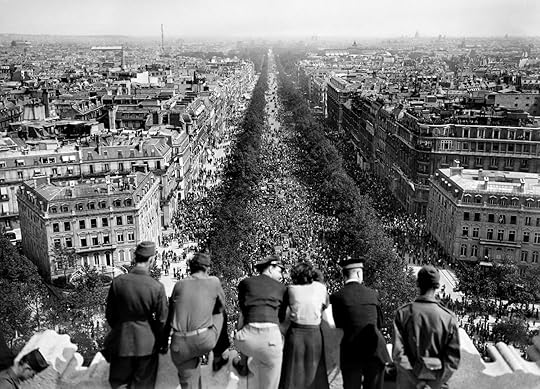
US Army personnel on top of l’Arc de Triomphe in Paris, France watching the celebration in the streets over the war in Europe coming to an end, 8 May 1945 (public domain via WW2 Database)
In London, the Royal Family and Prime Minister Winston Churchill appeared on the balcony of Buckingham Palace before a jubilant crowd. Princesses Elizabeth and Margaret, with permission from their parents, anonymously joined the rejoicing crowds in London, “swept along on a tide of happiness and relief.” (Read more: “The British Royal Family in World War II”)
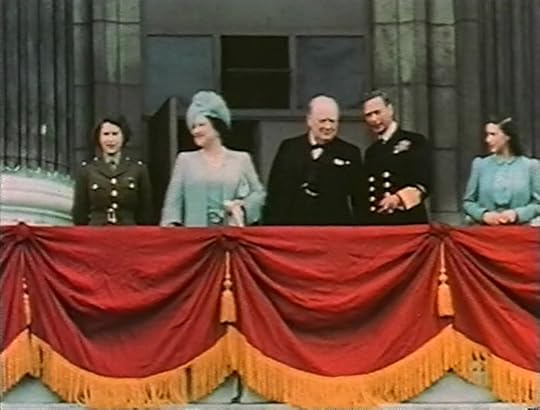
Princess Elizabeth, Queen Elizabeth, Winston Churchill, King George VI, and Princess Margaret on the balcony of Buckingham Palace, London, 8 May 1945 (US Army photo)
But V-E Day was also a day of solemn remembrance. Tens of millions had been killed in battle. More tens of millions had been murdered and starved in concentration camps. And tens of thousands had perished as civilian casualties of bombing. Many of Europe’s great cities lay in heaps of rubble.
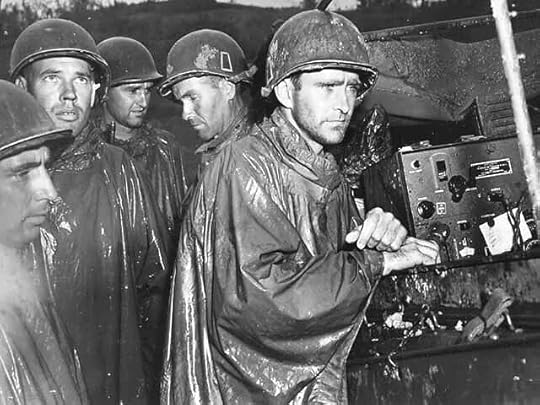
On Okinawa, men of the US 77th Infantry Division listen to the radio report of Germany’s surrender on May 8, 1945. One minute after this photo was taken, they returned to their combat posts. US forces on Okinawa celebrated V-E Day by training every ship and shore battery on a Japanese target and firing one shell simultaneously and precisely at midnight. (US National Archives: FA 41224- FA)
And World War II was far from over. In the Pacific, Allied forces were still fighting the Japanese in the East Indies, in the Philippines, in China, and on Okinawa. US forces on Okinawa commemorated V-E Day by simultaneously firing artillery and naval shells at midnight. Then they got back to the battle. V-J Day (Victory in Japan Day) wouldn’t arrive for three more months, on August 15, 1945, with the official end of World War II on September 2, 1945, six years and one day after it had begun.
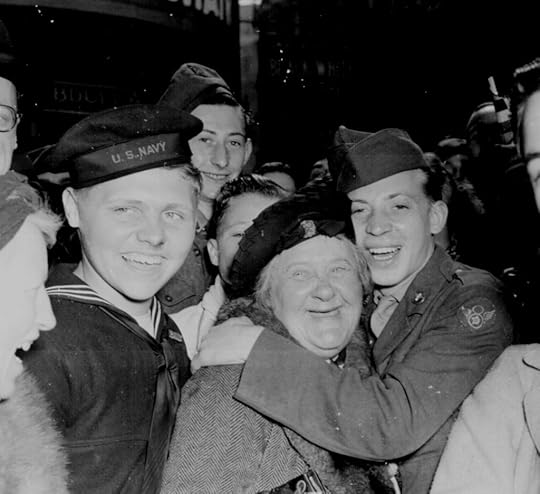
A jubilant American airman hugging an English woman at Piccadilly Circus, London, England, celebrating Germany’s unconditional surrender, 7 May 1945 (US National Archives: 111-SC-205398)
But for now, the free world rejoiced, and rightly so. Hitler and the Nazis had been defeated, and democracy would return to western Europe. They deserved to celebrate.
The post Victory in Europe! V-E Day 80th Anniversary! first appeared on Sarah Sundin.Today in World War II History—May 8, 1940 & 1945
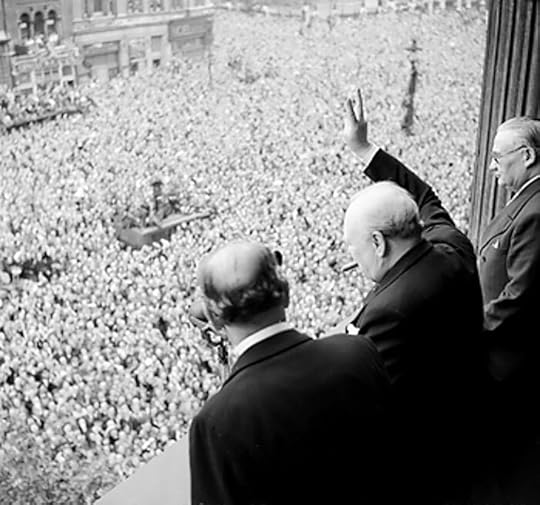
Churchill waving to crowds at Whitehall, London, on the day the war with Germany was won, 8 May 1945 (Imperial War Museum: 4700-37 H 41849)
85 Years Ago—May 8, 1940: British Labour Party calls for vote of no confidence in Prime Minister Neville Chamberlain’s government.
Gen. Semyon Timoshenko replaces Marshal Kliment Voroshilov as Soviet defense commissar.

Ground crew on a RAF Bomber Command station in Britain return the ‘V for Victory’ sign to a neighboring searchlight crew. Silhouetted is the nose of a Lancaster bomber (Imperial War Museum: CH 15165)
80 Years Ago—May 8, 1945: V-E Day (Victory in Europe Day)—the US and the western Allies celebrate as the German surrender becomes official. (Read more: V-E Day 80th Anniversary)
Off Bergen, Norway, an RAF Catalina sinks U-320, the last German U-boat sunk in the war.
US troops and Monuments Men discover art stash at Altaussee, Austria, saved by Austrian civilians.
US secures Leyte in the Philippines.
The post Today in World War II History—May 8, 1940 & 1945 first appeared on Sarah Sundin.May 7, 2025
Today in World War II History—May 7, 1940 & 1945
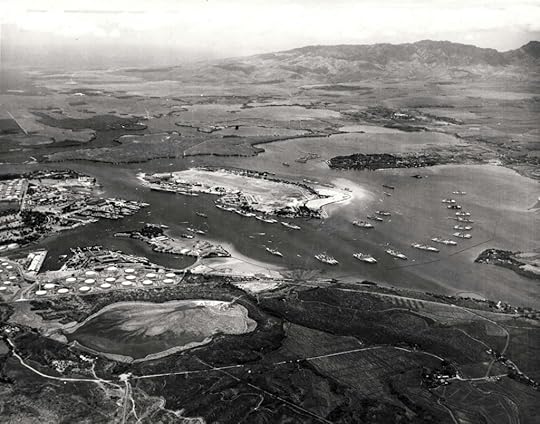
Pearl Harbor Naval Shipyard and Ford Island Naval Air Station, Oahu, Hawaii, May 2, 1940 (US Navy photo: 80-G-411119)
85 Years Ago—May 7, 1940: President Roosevelt orders the US Pacific Fleet to stay at Pearl Harbor indefinitely as a deterrent to Japan.

ColGen Alfred Jodl signing the documents of Germany’s surrender, Reims, France, 7 May 1945 (US National Archives: 195337)
80 Years Ago—May 7, 1945: Germany surrenders—Gen. Alfred Jodl signs unconditional surrender at Reims, France at 2:41 am, effective May 8.
Last victims of Battle of Atlantic—off the coast of Scotland, German U-boat U-2336 sinks Canadian transport Avondale Park and Norwegian transport Sneland I, and U-1023 sinks Norwegian minesweeper NYMS-382.
Soviets take Breslau after 82-day siege.
Pulitzer Prize in literature is awarded to John Hersey for A Bell for Adano.
The post Today in World War II History—May 7, 1940 & 1945 first appeared on Sarah Sundin.May 6, 2025
Today in World War II History—May 6, 1940 & 1945

First edition cover of The Grapes of Wrath by John Steinbeck, 1939
85 Years Ago—May 6, 1940: John Steinbeck is awarded the Pulitzer Prize for The Grapes of Wrath.
80 Years Ago—May 6, 1945: German SS troops try to crush uprising in Prague, Czechoslovakia, but resistance will prevail.
All Italy is occupied by the Allies.
Off Newfoundland, US destroyer escort Farquhar sinks German U-boat U-881, the last submarine sunk in the Atlantic by US forces.
The post Today in World War II History—May 6, 1940 & 1945 first appeared on Sarah Sundin.May 5, 2025
Today in World War II History—May 5, 1940 & 1945

Allied Third Burma Campaign, April-May 1945 (US Military Academy map)
85 Years Ago—May 5, 1940: Norwegian government-in-exile is established in London.
In Norway, Germans take fort of Hegra after a 25-day battle, the last Norwegian resistance in the south.
Off Denmark, damaged submarine HMS Seal surrenders to German seaplanes and a patrol vessel, the only British vessel surrendered by her commander during the war, the only sub captured at sea by Germany.
80 Years Ago—May 5, 1945: Allies secure Burma.
German SS unit assaults Schloss Itter in Austria, where high-ranking French POWs are being held—for the only time in the war, US and German forces fight side by side to defeat the SS troops.
In Lakeview, OR, one woman and five children are killed by a Japanese balloon bomb, the only civilians killed in the continental US by enemy action.
In the last German U-boat attack off the US coast, U-853 sinks US cargo ship Black Point.
The post Today in World War II History—May 5, 1940 & 1945 first appeared on Sarah Sundin.


